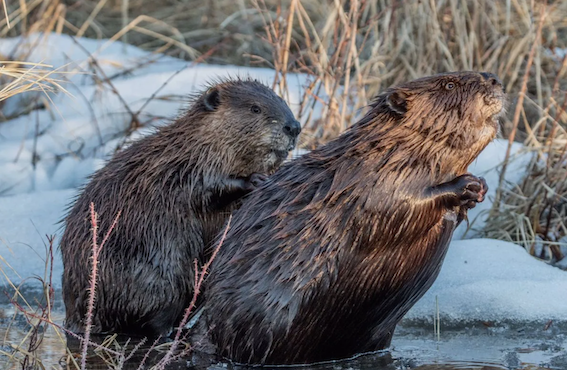by Camille Castor
Beavers, nature’s architects, are Canada’s national animal. For centuries their pelts were a major part of the fur trade, which fuelled exploration and development in North America. As our city has grown, they have continued to live in the waters and wetlands along the Bow River, Fish Creek Park, and Weaselhead Flats, where the Elbow River enters the Glenmore reservoir.
These industrious rodents not only thrive in this urban aquatic landscape but also play a significant role in shaping local ecosystems. With its big chisel-like front teeth, a single beaver could cut down around 200 trees annually. While beaver dams may benefit the environment of other species, in recent years, measures were taken to guard trees and drain beaver ponds next to main pathways that we humans use.
Beavers eat aquatic plants, grasses, rushes, sedges and (winter) bark and woody plants stored in or near their protective lodges. They build using tree branches, vegetation, rocks, and mud. They are strong and can pull heavy loads. Their thick fur is shed in the summer. It keeps them warm, helps them float, and protects them from bears and canine or feline predators. The beaver’s front feet are dexterous, allowing them to grasp and manipulate objects, as well as dig. Using just their larger hind feet (with webbing between the toes) and their big strong tails, they can swim at 8 kilometres per hour (5 miles per hour). They can hold their breath for up to 15 minutes
Beavers usually live up to 10 years and have up to four young, or kits, which are born in spring or early summer. Kits spend their first month or two in the lodge. When they first come out, they can be seen holding onto their parents’ backs. After their first year, they help their families with construction. They become independent at two-years-old but remain with their parents for an extra year or more during times of food shortage or drought. Beavers within a family greet each other with whining sounds. When being defensive, beavers produce a hissing growl and gnash their teeth. If walking near them at dawn or dusk you might hear a tail slap, which serves as an alarm to family members.
Beavers have successfully managed to continue to live in and around our growing urban centres. Although they are shy, you might still get a chance to see them in their wetland homes.

Click here to the Bayview Community News home page for the latest Bayview community updates.
Click here to the Palliser Community News home page for the latest Palliser community updates.
Click here to the Pumphill Community News home page for the latest Pumphill community updates.









